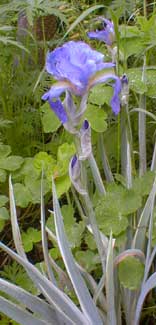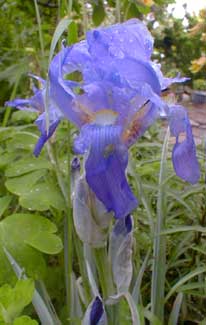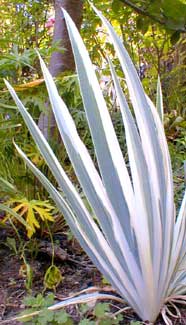
Variegated Sweet Iris; aka:
Variegated Orris Root,
Bearded Zebra Iris,
Dalmation Iris,
Floure-de-luce of Florence
or Florentine Iris
"How tall & slender suddenly
The stalks of purple iris blaze by the brooks."
-Robinson Jeffers
(1887-1962)
(1887-1962)
 In a nearby nursery this variegated form of Iris pallida var dalmatica was mislabeled 'Auria Variegata' but it is actually the Award of Garden Merit offering simply 'Variegata,' which is synonymous 'Alba' or 'Albo Variegata,' also offered as 'Argentea Variegata.' Both the gold or silver variegated forms are sometimes offered as 'Dalmatica.'
In a nearby nursery this variegated form of Iris pallida var dalmatica was mislabeled 'Auria Variegata' but it is actually the Award of Garden Merit offering simply 'Variegata,' which is synonymous 'Alba' or 'Albo Variegata,' also offered as 'Argentea Variegata.' Both the gold or silver variegated forms are sometimes offered as 'Dalmatica.'Ours has green leaves with silvery white stripes, whereas 'Auria' or 'Aurio Variegata' has distinctly golden stripes. About half the plants being offered by the nursery as golden variegated iris were indeed golden, but the other half were just as distinctly white. Seeing them side by side, we thought the white was far more dramatic.
 The striped leaves are certainly very striking, & last most of the year rather than dying back. In our mild winters it comes very close to being fully evergreen, & the fans of sabers are more than commonly well arranged. An iris this attractive whether in bloom or not is a very welcome addition to a sunny garden.
The striped leaves are certainly very striking, & last most of the year rather than dying back. In our mild winters it comes very close to being fully evergreen, & the fans of sabers are more than commonly well arranged. An iris this attractive whether in bloom or not is a very welcome addition to a sunny garden.Nay's large grape jelly-scented flower itself is also something special. The lavender-blue to pale lilac coloration is not the most common shade of purple or blue seen in other species. Its mild sweet perfume lends it the common name "Sweet Iris," plus it has a rather "fluffy" appearance to the center petals.
Ours in its first two years has only been about two feet tall, but it can reach three feet in flower. It is more tolerant of a bit of shade than are most irises, though full sun is best. When well-established it is somewhat drought tolerant, though moderate watering is preferred, except in winter.
Perfect drainage is essential, or it may rot in winter. It likes full sun though not too hot. When in flower shouldn't need staking if nearby shrubs protect it from too much wind. The thick root should be planted very near the surface, in rich humusy soil.
Iris pallida is native to northern Italy, Croatia, Bosnia & Slovenia. The variant dalmatica is from the southern Alps & Dalmatia, a province of Croatia. It has been used in many breeding programs since Colonial times & is one of the primary parents of the Bearded irises, the so-called I. germanica & I. florentina.
This species provides the orris root powder traditionally used by perfumers as a fixitive & for its own lasting violet scent. Since medieval times it was thought to have medicinal or at least magical & alchemical properties.